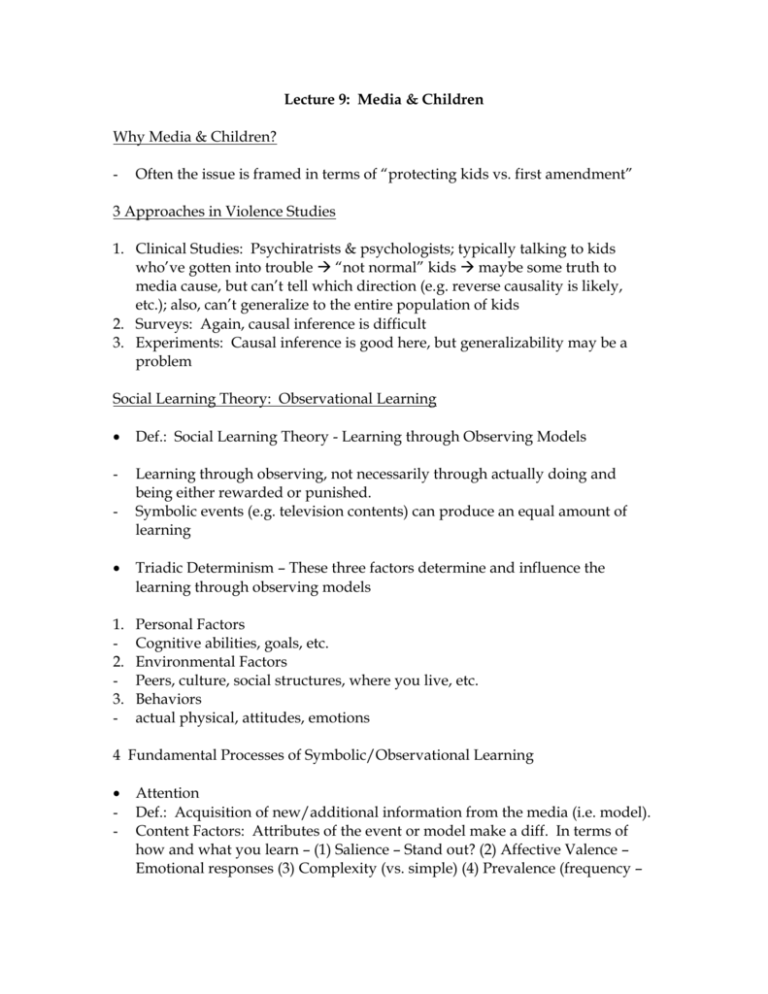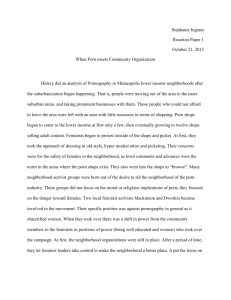doc
advertisement

Lecture 9: Media & Children Why Media & Children? - Often the issue is framed in terms of “protecting kids vs. first amendment” 3 Approaches in Violence Studies 1. Clinical Studies: Psychiratrists & psychologists; typically talking to kids who’ve gotten into trouble “not normal” kids maybe some truth to media cause, but can’t tell which direction (e.g. reverse causality is likely, etc.); also, can’t generalize to the entire population of kids 2. Surveys: Again, causal inference is difficult 3. Experiments: Causal inference is good here, but generalizability may be a problem Social Learning Theory: Observational Learning Def.: Social Learning Theory - Learning through Observing Models - Learning through observing, not necessarily through actually doing and being either rewarded or punished. Symbolic events (e.g. television contents) can produce an equal amount of learning - Triadic Determinism – These three factors determine and influence the learning through observing models 1. 2. 3. - Personal Factors Cognitive abilities, goals, etc. Environmental Factors Peers, culture, social structures, where you live, etc. Behaviors actual physical, attitudes, emotions 4 Fundamental Processes of Symbolic/Observational Learning - Attention Def.: Acquisition of new/additional information from the media (i.e. model). Content Factors: Attributes of the event or model make a diff. In terms of how and what you learn – (1) Salience – Stand out? (2) Affective Valence – Emotional responses (3) Complexity (vs. simple) (4) Prevalence (frequency – - - - - - ex) substance abuse) (5) functional value – useful to you? (e.g. for social purposes, etc.) Observer Factors: (1) Perceptual capabilities (e.g. eyesight, training in the area (music) (2) Perceptual set – Guides what you look at (3) Arousal level (e.g. a curvilinear relationship) (4) Acquisition preference – what you like and attend to Importance of “Consequences”: Pay more attention to the “rewarded” behaviors; Retention Def.: Encoding Then, storing for later retrieval & using for subsequent action Cognitive Rehearsal: Fantasizing images of yourself Rehearse in head (ski slope) for future use Anticipatory learning process Production Def.: Conversion of the symbolic representation into subseq1uent actions Appropriateness Cue: Similar setting & context from model to life (e.g. futuristic violence has typically less impact than realistic violence) Motivational Various Incentives: Why would you do the production processes? The most important issue here is the expected consequences/outcome. - External Incentives: Sensory, tangible (object) , social (acceptance) control - Vacarious Incentives: Indirect, abstract, delayed consequences. Departure from immediate, concrete consequences. Watch behaviors & consequences of others (kids need connections) - Self-Incentives: Reward oneself (tangible) & self evaluations (personal standards) Learning vs. Performance Distinction: Here the “Learning vs. Performance” distinction is extremely relevant & important Learning = Acquisition (Internal, unobservable), Performance = Later Behavior - Why Consequences is so important? Ex) Bandura Bobo doll experiment Boys more aggressive than girls Each more aggressive when rewarded vs. punished No consequences when expecting punishment almost indentical amount of aggressiveness as when rewarded No Consequence = Reward Then, when asked (= reward) to do it, they all do it. Shows that those who did not perform did learn Violence in Media 3 Major Effects of Viewing Symbolic Violence 1. Increased Aggressiveness Comstock: 4 Factors Mediating Responses to Symbolic Violence 1. Efficacy: Affect perception; worth learning; are there consequences (reward/punishment); does it work (utility) 2. Normativeness: Seems to be way the world is (the norm); justification of behaviors; intentionally hurtful 3. Pertinence: - Relate to your life? Cartoons as fantasy Not pertinent; Realistic is important for learning; but, fantasy found more powerful than control group, especially for younger viewers 4. Susceptibility - Learning vs. Performance Distinction Revisited: Again, this distinction is relevant If incentives are provided, then susceptible. 2. Desentization: - - People ignore real attack Media dampen our responses to plight of others? Increases amount of violence viewed, the level of sensitization over in physiological response decreases Overload Catharsis Hypothesis: A Countering hypothesis to the desensitization hypothesis Watch a lot of violence Releases violent impulses (without action) 3. Fear - Watching violence makes us more fearful (cultivation); change how people relate to each other - People tend to exaggerate the violence in the society Become fearful Cultivation studies is a good example Pornography - - Sex & Sexuality on Media: More graphic like violence Dramatic changes in movies Couldn’t show married couples in the same bed On TV, much more talk about sex Then, does this constant talk about and portrayal of sex have an impact on how people think & talk about sex? Does this change the views of children on marriage? Gender Differences Mostly, male uses. 3 Categories of Content 1. - Standard Porn Hard-core porn No violence (90%) Highly stylized & conventional Male audience Exclusive sex No conversation, affection, emotion, foreplay, safe sex No talk of consequences (e.g. pregnancy, etc.) Typically, women are eager, solicitate, hysterically euphoria. Degrading and no social relations. 2. - Violent (Coercive) Porn Approx. 5% of all porn. Violence Precursor to or integral part of sex Violence, rape, coercion, etc. Perpetuates “Rape Myth”: Women end up enjoying the abusive rape This is highly problematic 3. - Soft Porn: Idealized Sex Soft Porn (2-3%) Often called “erotica” Geared towards women audience Compassionate, dialogue, relationship, love, & foreplay 3 Models of Effects 1. Sexual Communication (Positive Effects) - This model argues that porn is “educational”/”theraputic” Positive consequences 2. Sexual Callousness (Feminist Model) - Lack of caring in porn creates detrimental perceptions of female sexuality (for men, too) - Promotes inter-gender violence - Creates misogynist cultural climate Legitimates hatred of women 3. Desensitization - Medium Differences: the medium of porn makes a difference. Most consistent effects are found in (1) print, (2) audio, then (3) video. Explanation: Print is less explicit, so YOU yourself fill in Another Experiment by Zillman: Showed that non-violent porn viewing could yield similar effects Studied the effects of repeated exposure w/ 180 college students (1/2 male and ½ female) More realistic than 1 time exposure studies Treatment Grp 1 Watched 1 hr. of porn every week for six weeks Treatment Grp 2 ½ hour porn, ½ hour non-porn Control Grp 1 no porn Control Grp 2 No film At 7th Week: Asked to watch soft porn, hard porn, and violent porn Got physiological responses to measure arousal level Grp 1 scored the lowest level of arousal At 10th Week (more importantly): Attitudes measured: Grp 1 & 2 Increased opinions of amount of rough sex, bestiality in society; Grp 1 Far less severe penalties for rapists Both males & females even though they did not see “violent porn”; neg. related to the support for women’s liberty & equality; Grp 1 Men Much more callous towards women Another study: Do implicit themes in porn influences other areas of our lives? Porn Grp & Non-porn Grp After 6 weeks Checked on “Control Items” (unrelated to sex or women The two groups were the same) Perceptions of others/about the world: Promiscuity in men/women “How natural or common do they think it is among other people the porn grp scored much higher “Faithfulness” The porn grp scored much lower - - - - - - Self Attitudes: Much more accepting of (1) extramarital sex (for yourself & for your partner), (2) non-exclusive sex, (3) more willing to take health risks (e.g. more likely to say, “multiple partners frees themselves from sexual repression”, etc.) As to Children: The porn grp much less decisive to have children As to “having boys vs. girls”: a huge drop for women to desire to have girls Degradation Personal Sexual Behavior: Decrease in satisfaction w/ the porn grp







